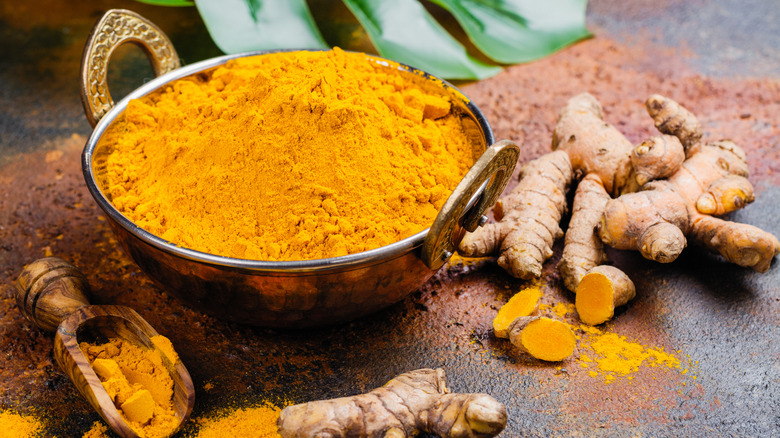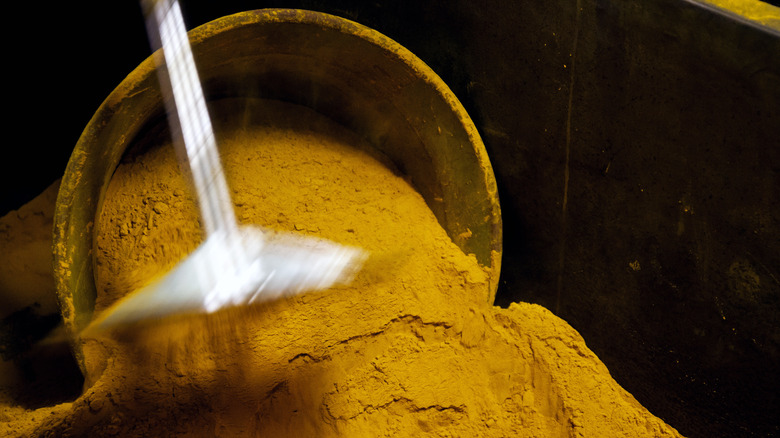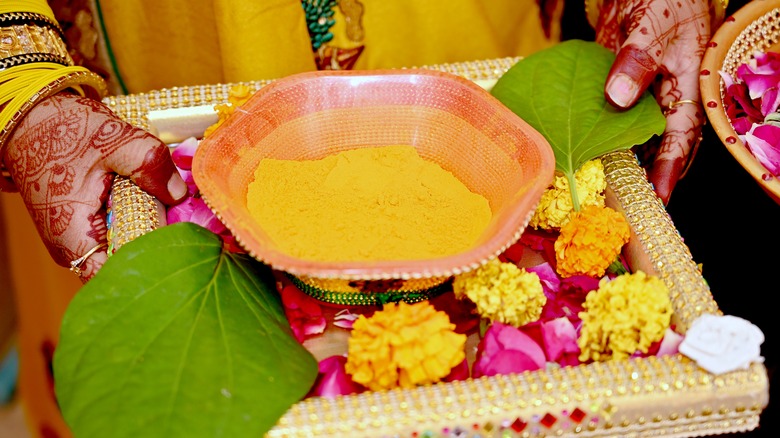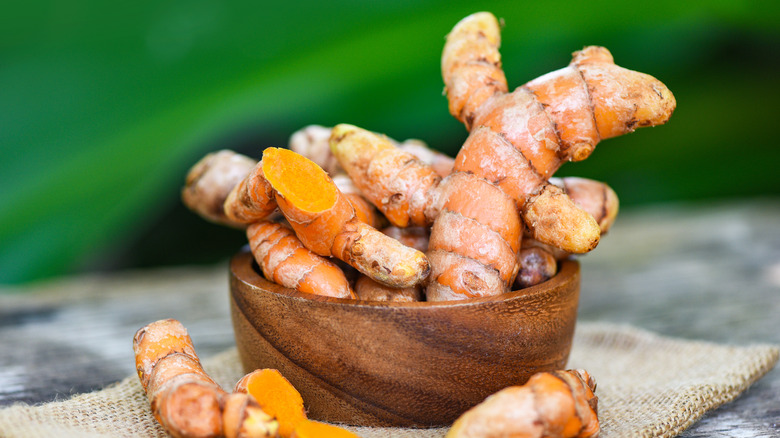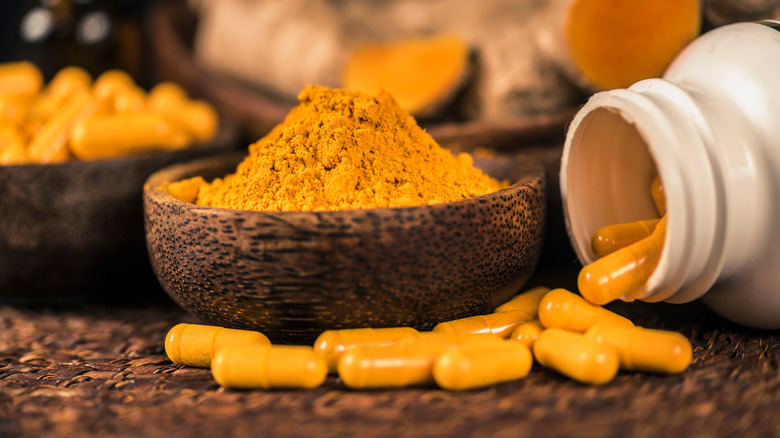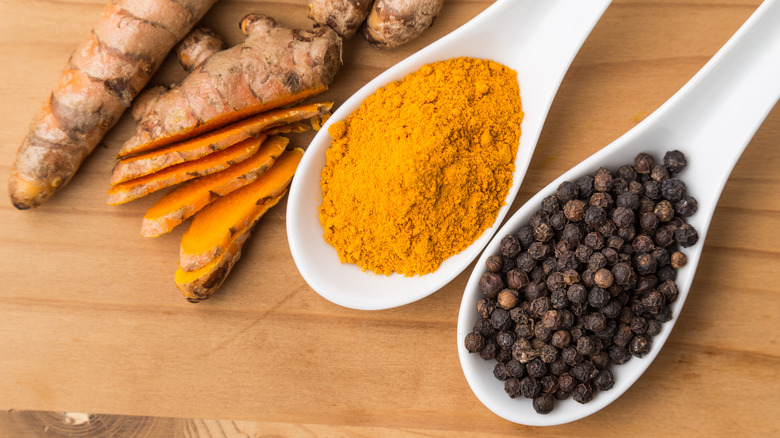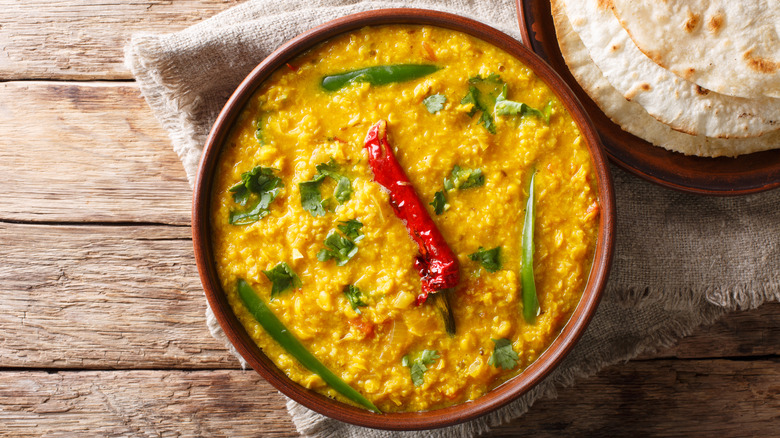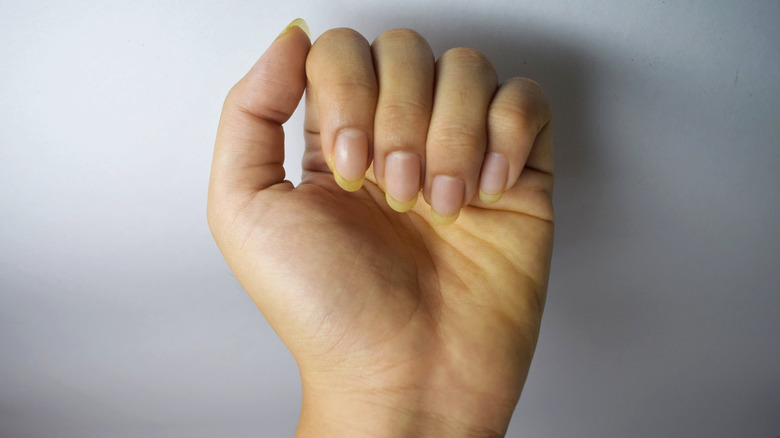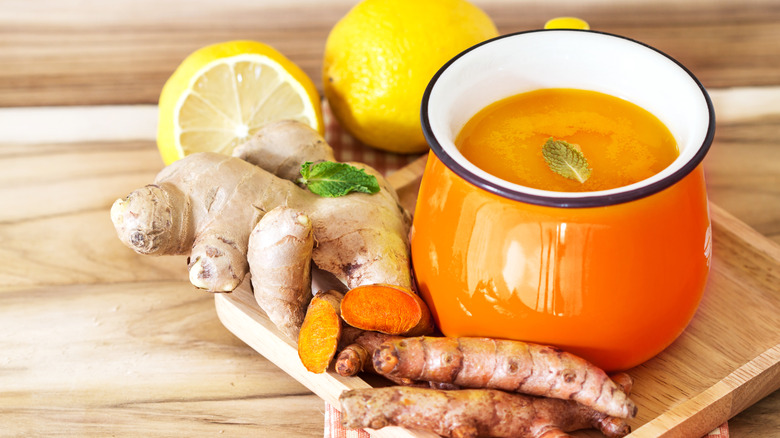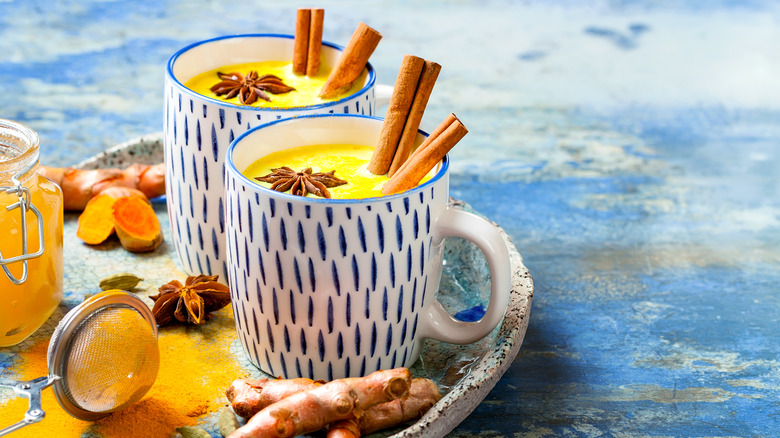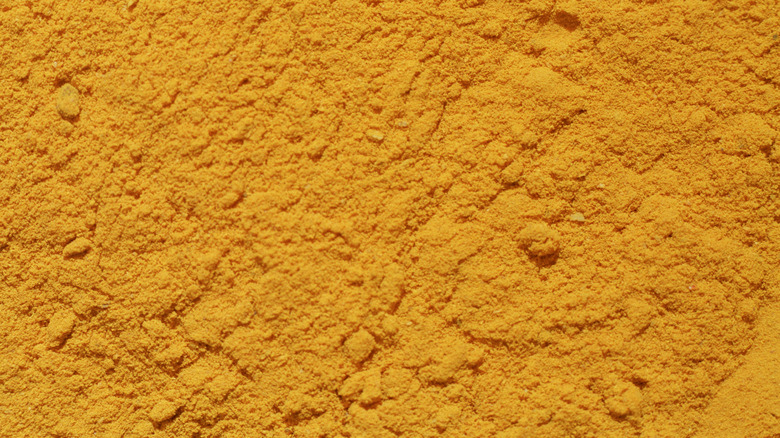The Untold Truth Of Turmeric
If you're interested in wellness and nutrition, chances are you've heard of turmeric being referred to as a superfood that has multiple health benefits. While superfood labels tend to claim that the food aids with multiple different ailments, it's certainly worth digging deeper to find out whether these claims are true. While many foods can appear in the wellness spotlight, it's important to distinguish between reality and fiction.
Turmeric does have some proven health benefits, such as possessing antioxidant and anti-inflammatory properties. Although turmeric is a current wellness trend, it has a rich history spanning thousands of years and it is associated with a wide range of religious, spiritual, and healing traditions. Turmeric was originally grown in India and Indonesia (via Britannica). Today, the plant can be found in powder form across the world.
Whether you're interested in turmeric for the purported health benefits or want to tinge your dishes with its vibrant hue, there's so much to know about this exciting ingredient.
Turmeric has been around for thousands of years
While turmeric has undoubtedly become more frequently used in American cooking, it has a long and rich history. According to PBS, turmeric can be traced back to New Delhi around 2,500 B.C. There are even reports of turmeric existing and being used 6,000 years ago (via Advances in Anthropology).
Furthermore, turmeric has been used in Ayurvedic medicine since 500 B.C. Marco Polo came across turmeric in his extensive travels and noted its similarity to saffron (via McCormick Science Institute). In medieval Europe, turmeric was even referred to as Indian saffron for some time.
People and cultures have found numerous different ways of using this brightly colored spice; turmeric has been used for healing purposes as well as spiritual practices and rituals. People in certain parts of India dye textiles with turmeric.
However, it has taken a few thousand years for turmeric to make its way into mainstream cookbooks and Western spice cabinets. Nowadays, you can't avoid it in wellness circles, yet, turmeric owes its fame in large part to its overwhelming history.
It is an important element of numerous spiritual practices
Turmeric plays a significant role in several religious and spiritual rituals. According to a study published in Advances in Anthropology, due to its vibrant color, countless populations in Southern Asia have revered turmeric and have named it the "golden spice," likely due to its coloring and appearance.
The role of turmeric in the Hindu religion is notable: Many brides weave a piece of turmeric into their marriage necklaces to fend off evil spirits and to attract good luck for the commencement of the marital journey. Additionally, Temples in India Info notes that turmeric is believed to bring fertility and purity, which explains why it is a key element in important ceremonies like weddings.
The powder is also used in various other symbolic traditions, such as decorating statues of gods and goddesses. Similarly, clothes and textiles are often dyed with turmeric's bright yellow color to evoke Lord Krishna, who is often depicted dressed in yellow clothes.
A review published in Archaeology & Anthropology in 2020 highlights the uses of turmeric in Buddhist culture, particularly as a dye for robes that are worn by monks. Elsewhere in the world, Hawaiian shamans have been known to incorporate it in medicinal and spiritual rites. Meanwhile, Ayurvedic tradition has long embraced turmeric for its mind and body balancing qualities (via Classroom).
It's not technically a root
Turmeric is often referred to as a "root" in daily conversation, but botanically speaking, it is actually a rhizome, which, as MasterClass explains, is a word that refers to a mass of roots though it actually references stems that grow underground. If you've only ever seen turmeric in powder form, let's backtrack and note that turmeric looks a fair bit like ginger root, which makes sense since the two are related (via Britannica).
In the case of turmeric, the rhizome just below the soil's surface gives way to leaves and flowers that grow just above the soil's surface. The knobby stem is harvested for consumption. The rhizome must be boiled for processing and dried in the sun for around a week, before being sold in whole or powdered form. The whole edible rhizome can be added to stews, soups, smoothies, tea, butter, and salads.
Its active ingredient has several health benefits
With so much fanfare surrounding the health benefits of this vibrant yellow substance, it's worth digging deeper to learn more about the health claims. While no single ingredient should be considered a miracle across the board, turmeric does have some points in its favor.
For starters, the majority of the benefits associated with ingesting turmeric can be attributed to the active compound curcumin. According to a 2009 study published in the American Chemical Society, curcumin plays a stabilizing role in cells and improving their ability to fight infections and disease.
According to BBC Good Food, curcumin acts as an antioxidant to reduce inflammation that can lead to a host of other health problems. Consequently, issues like arthritis, heart disease, cancer, and type 2 diabetes are potentially attenuated by its presence. Healthline notes that these benefits extend to various other age-related diseases, including cognitive ones like Alzheimer's disease.
Additionally, turmeric also aids daily bodily functions: According to Medical News Today, turmeric has long been used in Ayurvedic nutrition to support healthy digestion due to its anti-inflammatory and antioxidant characteristics. While some people do take curcumin supplements to gain the full effect of the possible benefits, it's well worth speaking to your doctor first as these supplements can react when paired with other medications (via NBC News).
Turmeric isn't easily absorbed by the human body
Unfortunately, for an ingredient with so many touted benefits, the body's ability to absorb turmeric is quite limited (via NBC News). Nonetheless, as noted in a 2007 study published in Molecular Pharmacology, countless scientists have focused on finding ways to enhance its bioavailability in an attempt to use the spice for therapeutic purposes. While some researchers believe that increasing the bioavailability of turmeric is far too difficult, as evidenced by a 2017 study in the Journal of Medicinal Chemistry, others are actively seeking solutions to increase its absorption.
All the same, you won't lose anything by including the yellow spice in your diet or trying supplements formulated for greater bioavailability. If you're looking for an added healing benefit, Healthline notes that most research studies work with pure curcumin, in quantities of around one gram. You would have to eat a frightening amount of turmeric to obtain this amount, so you would be better off taking curcumin in a capsule format to increase the rate of absorption.
Heat and certain ingredient combinations optimize turmeric's properties
According to Healthline, even if you take pure curcumin supplements, you'll need an extra oomph to enhance your body's ability to absorb this substance. According to the results from a study published in Planta Medica in 1998, piperine (found in black pepper) increases your body's ability to hold onto curcumin by up to 2,000%. Piperine slows down the metabolization of turmeric's active compound, leaving it available for your body to absorb.
If you're going the supplement route, it's best to choose options that also contain piperine to improve the potential effects. Meanwhile, if you want to include turmeric in a well-rounded diet, make sure to add some freshly ground black pepper to whatever concoction you are whipping up. According to Medical News Today, other substances like bromelain, which is found in pineapples, appear to enhance curcumin absorption as well.
Additionally, NutritionFacts.org highlights that combining turmeric with a source of fat makes it more soluble and consequently easier to absorb. Similarly, cooking turmeric improves the spice's bioavailability, as nutritionist Dr. Rupali Dutta tells NDTV Food. So while a shot of raw turmeric juice might not do much, simmering it in a coconut milk curry is likely to have more benefits.
It can be used in skincare routines
While you may be familiar with the use of turmeric in cooking and recipes, it also plays a role in traditional and modern-day skincare regimens as well. Healthline notes that the spice's antioxidant and anti-inflammatory properties can boost your natural glow and improve your skin. These characteristics could even help reduce scars from acne and any other blemishes and facilitate a smooth complexion.
Allure spoke with two dermatologists who were enthusiastic about including turmeric in skincare routines; however, they both emphasized the importance of testing a patch of skin first to ensure you have no adverse reactions. This goes for both products formulated with turmeric and any DIY masks or creams you choose to experiment with.
If you're worried that you'll remain yellow, Dr. De Anne Harris Collier recommends wiping your face with a pad tinged with olive or coconut oil to remove any excess residue. Similarly, watch out for your white pillowcase if you're applying a turmeric mask at night.
Removing turmeric stains can be quite tricky
Turmeric can leave a stain. This shouldn't come as a surprise given its significant uses as a textile dye (via PBS). Nonetheless, unless you're looking for a splash of color in your wardrobe, knowing how to get rid of the stains is crucial. Of course, depending on the material, the results might not be completely perfect so keep that in mind before filling your favorite plastic container with a turmeric-rich sauce.
For stained dishes (ceramic, plastic, and glass), Food52 recommends using a two-to-one ratio of hot water to bleach (or pure white vinegar if you're reluctant to use bleach). Let the mixture soak in the vessel overnight, then wash it as you would with soap and water. For countertops, options like a baking soda paste with vinegar and lemon, or a Magic Eraser can all work; or, step back and simply allow the sun to lighten the stain over time.
According to Better Homes & Gardens, fabrics (clothes or kitchen towels), can benefit from a spot treatment of laundry detergent and a cold water cycle wash whereas stains on white clothes are suited to a light scrub with a baking soda paste for white clothes.
Hanging white items to dry in the sun should also enhance the results. As for your hands and nails, start with rubbing alcohol, then combine lemon juice and baking soda to make a paste for further scrubbing.
It is sometimes used to detoxify the liver
While undergoing an explicit detox can be quite dangerous and certainly isn't recommended by experts, Eastern medicine and Ayurveda use turmeric to treat a number of conditions related to the liver and to detoxify harmful elements in the body (via Herbal Medicine). According to a book entitled "Herbal Medicine: Biomolecular and Clinical Aspects," the plant's key compound, curcumin, appears to improve certain types of liver damage. The effects seem to be due to its antioxidant properties which work to protect the organ.
Medical News Today suggests turmeric could be useful in promoting liver function for people who must take very strong medications over long periods of time. Meanwhile, a 2013 study published in Biofactors demonstrated that turmeric could help minimize processes that lead to fatty liver disease.
All the same, the consequences are not universal: BBC Good Food remarks that since turmeric can stimulate the release of bile, it may pose problems for people with liver disease. If you're simply including a moderate amount of turmeric in your diet, then you gain some additional benefits as a bonus. However, if you are looking to use turmeric medicinally, then it is highly recommended to seek a professional opinion first.
Consuming turmeric might help boost your mood
Turmeric's influence on physical conditions is frequently discussed, but it also has some mental benefits. A number of research studies have explored the effects of using turmeric to treat depression. According to a review of the book "The Inflamed Mind" by Edward Bullmore, there is evidence that points to the connection between inflammation in the body and depression (via Nature).
According to a 2014 study published in Phytotherapy Research, therapeutic interventions using curcumin supplements in people with major depressive disorder were found to have successful results. Healthline highlights numerous other studies that have found positive outcomes regarding incorporating curcumin into treatments for depression.
In 2018, an article in The American Journal of Geriatric Psychiatry reported that curcumin supplements boosted memory in adults with no preexisting signs of dementia. In addition to slowing down signs of decline, brain scans showed reduced matter associated with Alzheimer's. The researchers noted that the frequency of Alzheimer's in Indian people who tend to regularly consume turmeric is lower as compared to people in other countries.
Furthermore, participants noted improved mood, and that's just one more reason to include turmeric in your diet. There is still lots to learn about the interaction of curcumin with these brain processes, yet the possible implications are certainly encouraging.
It can be found in trendy coffee shop drinks
There are endless ways to add turmeric to recipes, and one of these entails adding the condiment to various drinks. According to The Guardian, by the end of 2015, cafes in London jumped on the golden milk train, thus reviving a drink with years of tradition. According to Google's figures, searches for turmeric increased by 56% between 2015 and 2016.
Starbucks started selling turmeric lattes in 2017; however, the item was limited to its London locations. All the same, the company divulged its turmeric latte recipe featuring ingredients like oat milk, espresso, vanilla, turmeric, cinnamon, ginger, black pepper, and honey. Goop has a recipe for golden milk that can be made vegan friendly through the use of plant-based milk. The golden milk drink contains a medley of spices such as cardamom, nutmeg, black pepper, and cinnamon in addition to the ground turmeric.
Meanwhile, writers at The New York Times and BBC among others share memories of sipping on golden milk or haldi doodh (the Hindi name) at home when they were sick. Indeed, there is nothing new about the milky spiced turmeric concoction, and while the Western world has only just started raving over it, people accustomed to the classic are both curious and amused (via India Today).
A case of turmeric forgery made headlines
According to The Indian Express, In 1982, a man in India was sent to jail for one month with a fine of a bit over $6 for engaging in turmeric forgery. However, it took almost 40 years for the courts to announce their verdicts, making the case a poignant example of the issues within India's justice system. Apart from what this example says about the lengthy time required for Indian judiciary processes, it's worth noting the crime in question and the issue of additives in turmeric.
As the American Botanical Council reports, turmeric is prone to being tainted with additives. Assorted starches, chalk, cassava powder, and artificial dyes are common examples of extraneous materials added to the spice before it is sold. While some additives are relatively innocuous (although pure turmeric is undoubtedly more desirable), a 2019 Stanford University study published in Environmental Research found toxic lead chromate in numerous turmeric samples from Bangladesh.
The Food Safety & Standards Authority of India released a video on Twitter demonstrating a quick test to determine whether your turmeric is adulterated or not. Add some powder to a glass of water; pure turmeric will only slightly alter the color and mostly drop to the bottom, whereas the fake stuff will brightly dye the water. Times of India shares a number of other tests to check the purity of your turmeric, such as rubbing it into your palm to see if it stains (the real stuff should).
